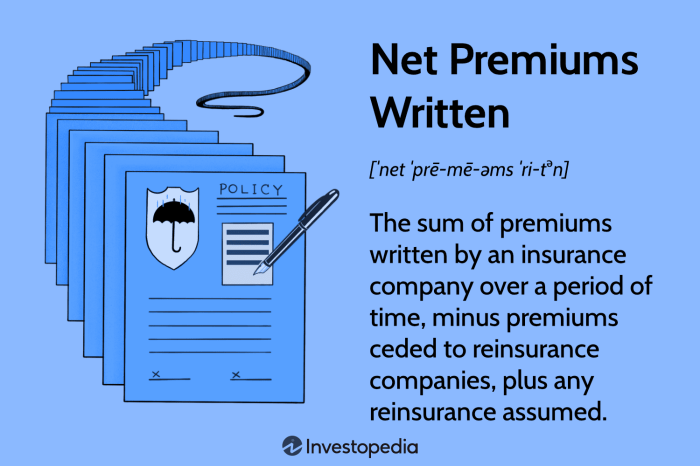Insurance premiums: the price we pay for peace of mind. But what exactly constitutes this crucial element of insurance? This guide delves into the multifaceted world of insurance premiums, unraveling the complexities behind their calculation, payment, and adjustments. We’ll explore the factors that influence premium costs, the various payment options available, and the circumstances under which adjustments or refunds might be considered, providing a clear and comprehensive understanding of this fundamental aspect of insurance.
From the basic definition of a premium to the intricate calculations performed by actuaries, we’ll cover the spectrum of premium-related information. This guide aims to empower you with the knowledge necessary to navigate the insurance landscape with confidence, making informed decisions about your coverage and payments.
Defining “Premium” in Insurance

An insurance premium is essentially the price you pay to an insurance company for an insurance policy. It’s the agreed-upon amount that secures your coverage against specified risks, such as accidents, illnesses, or property damage. Think of it as your monthly or annual membership fee for protection.
Components of an Insurance Premium
Several factors influence the cost of an insurance premium. These factors are carefully assessed by insurance companies to determine the level of risk associated with insuring you. A higher risk profile typically translates to a higher premium. Key components include the type of coverage, your individual risk profile (age, health, driving history, location, etc.), the coverage limits, and the insurance company’s operational costs and profit margins. The more comprehensive the coverage and the higher the risk, the greater the premium.
Premium Variations Across Insurance Types
Insurance premiums vary significantly across different types of insurance. For instance, health insurance premiums are influenced by factors like age, pre-existing conditions, chosen plan (e.g., bronze, silver, gold), and the location of the healthcare providers in your network. Auto insurance premiums consider your driving record (accidents, tickets), vehicle type, location (urban areas tend to have higher rates), and coverage limits (liability, collision, comprehensive). Home insurance premiums are affected by the value of your home, its location, the presence of security systems, and the coverage you select (e.g., coverage for specific perils).
Comparison of Premiums from Different Providers
The following table illustrates how premiums for similar coverage can vary between different insurance providers. Note that these are illustrative examples and actual premiums will depend on individual circumstances and may change over time.
| Insurance Type | Provider A | Provider B | Provider C |
|---|---|---|---|
| Auto Insurance (Liability Only) | $500/year | $600/year | $450/year |
| Homeowners Insurance ($250,000 coverage) | $800/year | $950/year | $750/year |
| Health Insurance (Silver Plan) | $400/month | $350/month | $450/month |
Factors Affecting Premium Costs
Insurance premiums, the price you pay for coverage, aren’t arbitrarily set. Numerous factors contribute to the final cost, reflecting a complex interplay of risk assessment and actuarial modeling. Understanding these factors empowers consumers to make informed decisions about their insurance choices and potentially reduce their premiums.
Several key elements influence the calculation of insurance premiums. These factors are carefully weighed by insurance companies to accurately assess the likelihood and potential cost of future claims. The goal is to create a financially sound system where premiums collected are sufficient to cover claims and operational expenses, while remaining competitive in the marketplace.
Individual Risk Profiles and Premium Calculations
Individual characteristics significantly impact premium calculations. Insurance companies analyze a range of personal details to create a risk profile. This profile helps determine the likelihood of the individual needing to file a claim. For example, a young driver with a history of accidents will generally pay higher car insurance premiums than an older driver with a clean driving record. Similarly, someone with a pre-existing medical condition may face higher health insurance premiums compared to a healthier individual. The more risk an individual presents, the higher the premium. This is a fundamental principle of insurance: those perceived as higher risk subsidize the lower-risk individuals.
The Role of Actuarial Science in Premium Determination
Actuarial science plays a critical role in setting insurance premiums. Actuaries are highly trained professionals who use statistical models and historical data to predict future claims. They analyze vast datasets, including demographic information, claims history, and economic trends, to assess the probability and severity of future events. Their sophisticated analyses help insurance companies accurately price policies, ensuring financial stability and responsible risk management. For instance, actuaries might use historical data on car accidents to predict the likelihood of accidents in a particular geographic area and adjust premiums accordingly.
Lifestyle Choices and Premium Costs
Lifestyle choices significantly influence insurance premiums across various types of coverage. Insurance companies recognize that certain behaviors increase the risk of claims.
- Smoking: Smoking significantly increases the risk of various health problems, leading to higher health and life insurance premiums.
- Diet and Exercise: A healthy lifestyle, including a balanced diet and regular exercise, can contribute to lower health insurance premiums. Individuals demonstrating commitment to wellness may qualify for discounts.
- Driving Habits: Speeding tickets, accidents, and DUI convictions dramatically increase car insurance premiums. Safe driving practices are rewarded with lower premiums.
- Home Security: Installing security systems and taking other measures to protect your home can lead to lower homeowner’s insurance premiums. These actions demonstrate a reduced risk of theft or damage.
- Occupation: High-risk occupations, such as construction work or firefighting, can lead to higher life and disability insurance premiums due to increased injury risk.
Understanding Premium Structures and Components

Insurance premiums aren’t a single, monolithic fee; rather, they’re constructed from various elements and can take different forms depending on the insurer and the specific policy. Understanding these structures and components is crucial for making informed decisions about your insurance coverage.
Different premium structures allow insurance companies to tailor their pricing to the risk profiles of individual policyholders. This ensures that premiums reflect the likelihood of claims, promoting a fairer system where those with lower risks pay less. The components within the premium itself represent the various costs associated with providing insurance coverage.
Premium Structure Variations
Insurance companies employ several methods for determining premiums. A flat-rate structure charges a consistent premium regardless of individual risk factors. This is often seen in simpler insurance products. Tiered rate structures, on the other hand, categorize policyholders into different risk groups based on factors like age, location, or driving history, assigning premiums accordingly. For example, a car insurance company might offer lower premiums to drivers with clean records compared to those with multiple accidents. A usage-based insurance model, becoming increasingly prevalent, adjusts premiums based on actual driving behavior tracked through telematics devices. This allows for more personalized pricing reflecting individual driving habits.
Impact of Add-ons and Riders
Add-ons, also known as riders, are supplemental coverages that enhance the basic policy. These additions provide broader protection but naturally increase the premium. For instance, adding roadside assistance to a car insurance policy will increase the premium, as the insurer assumes additional financial responsibility. Similarly, adding disability coverage to a life insurance policy will raise the premium, as the insurer takes on the risk of paying out benefits if the policyholder becomes disabled. The cost of these add-ons varies based on the extent of coverage provided. A comprehensive roadside assistance package will cost more than a basic one.
Premium Components
A typical insurance premium comprises several key components. A significant portion covers claims reserves, which are funds set aside to pay future claims. The larger the potential for claims, the higher this reserve will be. Administrative expenses, encompassing salaries, office space, and technology, also contribute to the premium. Profit margins, allowing the insurer to remain financially viable, are another integral part. Reinsurance costs, incurred when the insurer transfers a portion of the risk to another company, may also be included, particularly for high-risk policies. Finally, taxes and regulatory fees, levied by governmental authorities, add to the overall premium.
Illustrative Premium Breakdown
Imagine a simplified car insurance premium of $1000. A possible breakdown might look like this: Claims reserves: $600 (60%), Administrative expenses: $200 (20%), Profit margin: $100 (10%), Reinsurance: $50 (5%), Taxes and fees: $50 (5%). This is a hypothetical example, and the actual proportions will vary significantly depending on factors like the type of insurance, the risk profile of the policyholder, and the specific insurer. The percentages provided are illustrative and should not be considered accurate representations of real-world distributions.
Conclusion

Understanding insurance premiums is key to responsible financial planning and securing adequate coverage. By grasping the factors influencing premium costs, available payment methods, and the processes for adjustments and refunds, you can effectively manage your insurance policies and ensure you receive the protection you need. This guide serves as a foundational resource, empowering you to engage confidently with your insurance provider and make well-informed choices about your financial security.
FAQs
What happens if I can’t afford my insurance premium?
Many insurers offer payment plans or flexible payment options. Contact your provider to discuss potential solutions, such as installment payments or alternative payment methods.
Can I negotiate my insurance premium?
While not always guaranteed, you can try negotiating your premium by shopping around for quotes, bundling policies, or improving your risk profile (e.g., installing security systems for home insurance).
How often are insurance premiums typically due?
Premiums are typically due monthly, quarterly, semi-annually, or annually, depending on your policy and insurer.
What factors influence the premium for a young driver?
Young drivers typically pay higher premiums due to higher accident risk. Factors include age, driving experience, location, and the type of vehicle.